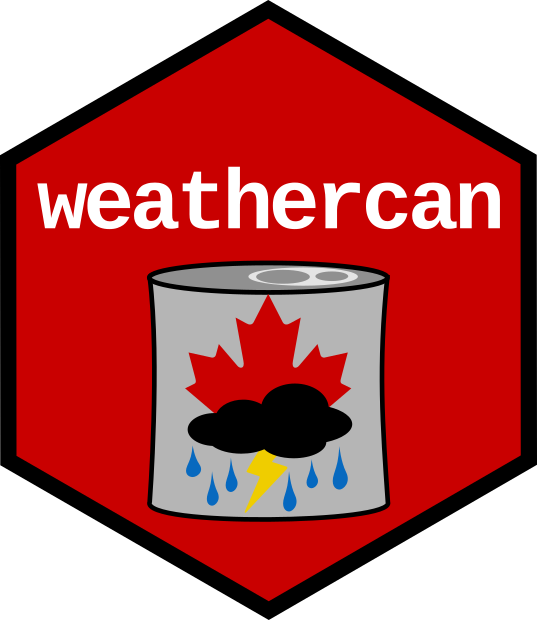56 * 5.8[1] 324.8
steffilazerte
@steffilazerte@fosstodon.org
steffilazerte.ca

Compiled: 2025-10-27

Artwork by @allison_horst
A programming language is a way to give instructions in order to get a computer to do something
R, what is 56 times 5.8?


We’re using weathercan today


We’re using both RStudio and R today



Moral of the story?
Make friends, code in groups, learn together and don’t beat yourself up

Artwork by @allison_horst

1library(weathercan)
2stations()
3stations_search("Brandon")
4w <- weather_dl("49909", start = "2025-09-01")
5n <- normals_dl("5010480")library() function
stations() function to get a list of stations
stations_search() function to search for a station
weather_dl() to download recent data by station_id
normals_dl() to download climate normals by climate_id
That’s it! Workshop over 😁
?weather_dlTo cite 'weathercan' in publications, please use:
LaZerte, Stefanie E and Sam Albers (2018). weathercan: Download and format weather data from Environment
and Climate Change Canada. The Journal of Open Source Software 3(22):571. doi:10.21105/joss.00571.
A BibTeX entry for LaTeX users is
@Article{,
title = {{weathercan}: {D}ownload and format weather data from Environment and Climate Change Canada},
author = {Stefanie E LaZerte and Sam Albers},
journal = {The Journal of Open Source Software},
volume = {3},
number = {22},
pages = {571},
year = {2018},
url = {https://joss.theoj.org/papers/10.21105/joss.00571},
}flagsglossaryglossary_normals# A tibble: 16 × 2
code meaning
<chr> <chr>
1 A Accumulated
2 B More than one occurrence and estimated
3 C Precipitation occurred, amount uncertain
4 D Data subject to further quality control procedure
5 E Estimated
6 F Accumulated and estimated
7 L Precipitation may or may not have occurred
8 M Missing
9 N Temperature missing but known to be > 0
10 S More than one occurrence
11 T Trace
12 Y Temperature missing but known to be < 0
13 [empty] Indicates an unobserved value
14 ^ The value displayed is based on incomplete data
15 † Data that is not subject to review by the National Climate Archives
16 <NA> Not Available Where?
stations()# A tibble: 26,451 × 17
prov station_name station_id climate_id WMO_id TC_id lat lon elev tz interval start end normals
<chr> <chr> <dbl> <chr> <dbl> <chr> <dbl> <dbl> <dbl> <chr> <chr> <dbl> <dbl> <lgl>
1 AB DAYSLAND 1795 301AR54 NA <NA> 52.9 -112. 689. Etc/GMT+7 day 1908 1922 FALSE
2 AB DAYSLAND 1795 301AR54 NA <NA> 52.9 -112. 689. Etc/GMT+7 hour NA NA FALSE
3 AB DAYSLAND 1795 301AR54 NA <NA> 52.9 -112. 689. Etc/GMT+7 month 1908 1922 FALSE
4 AB EDMONTON CORONATION 1796 301BK03 NA <NA> 53.6 -114. 671. Etc/GMT+7 day 1978 1979 FALSE
5 AB EDMONTON CORONATION 1796 301BK03 NA <NA> 53.6 -114. 671. Etc/GMT+7 hour NA NA FALSE
6 AB EDMONTON CORONATION 1796 301BK03 NA <NA> 53.6 -114. 671. Etc/GMT+7 month 1978 1979 FALSE
7 AB FLEET 1797 301B6L0 NA <NA> 52.2 -112. 838. Etc/GMT+7 day 1987 1990 FALSE
8 AB FLEET 1797 301B6L0 NA <NA> 52.2 -112. 838. Etc/GMT+7 hour NA NA FALSE
9 AB FLEET 1797 301B6L0 NA <NA> 52.2 -112. 838. Etc/GMT+7 month 1987 1990 FALSE
10 AB GOLDEN VALLEY 1798 301B8LR NA <NA> 53.2 -110. 640 Etc/GMT+7 day 1987 1998 FALSE
# ℹ 26,441 more rows
# ℹ 3 more variables: normals_1991_2020 <lgl>, normals_1981_2010 <lgl>, normals_1971_2000 <lgl>stations_dl()According to Environment Canada, Modified Date: 2025-10-08 23:30 UTCEnvironment Canada Disclaimers:
"Station Inventory Disclaimer: Please note that this inventory list is a snapshot of stations on our website as of the modified date, and may be subject to change without notice."
"Station ID Disclaimer: Station IDs are an internal index numbering system and may be subject to change without notice."Stations data saved...
Use `stations()` to access most recent version and `stations_meta()` to see when this was last updatedstations_search()# A tibble: 17 × 17
prov station_name station_id climate_id WMO_id TC_id lat lon elev tz interval start end normals
<chr> <chr> <dbl> <chr> <dbl> <chr> <dbl> <dbl> <dbl> <chr> <chr> <dbl> <dbl> <lgl>
1 MB BRANDON #1 WINTER BAY 3474 5010498 NA <NA> 49.8 -100.0 396 Etc/G… day 1987 2002 FALSE
2 MB BRANDON #1 WINTER BAY 3474 5010498 NA <NA> 49.8 -100.0 396 Etc/G… month 1987 2002 FALSE
3 MB BRANDON A 3471 5010480 71140 YBR 49.9 -100.0 409. Etc/G… day 1941 2012 TRUE
4 MB BRANDON A 3471 5010480 71140 YBR 49.9 -100.0 409. Etc/G… hour 1958 2012 TRUE
5 MB BRANDON A 3471 5010480 71140 YBR 49.9 -100.0 409. Etc/G… month 1941 2012 TRUE
6 MB BRANDON CDA 3472 5010485 NA <NA> 49.9 -100.0 363. Etc/G… day 1890 2010 TRUE
7 MB BRANDON CDA 3472 5010485 NA <NA> 49.9 -100.0 363. Etc/G… month 1890 2007 TRUE
8 MB BRANDON MUNI A 50821 5010481 71140 YBR 49.9 -100.0 409. Etc/G… day 2012 2025 TRUE
9 MB BRANDON MUNI A 50821 5010481 71140 YBR 49.9 -100.0 409. Etc/G… hour 2012 2025 TRUE
10 MB BRANDON MUNI A 55738 5010482 71140 YBR 49.9 -100.0 409. Etc/G… day 2025 2025 FALSE
11 MB BRANDON MUNI A 55738 5010482 71140 YBR 49.9 -100.0 409. Etc/G… hour 2025 2025 FALSE
12 MB BRANDON RCS 49909 5010490 71136 PBO 49.9 -100.0 409. Etc/G… day 2012 2025 FALSE
13 MB BRANDON RCS 49909 5010490 71136 PBO 49.9 -100.0 409. Etc/G… hour 2012 2025 FALSE
14 MB BRANDON SOUTH 3473 5010494 NA <NA> 49.8 -100.0 396. Etc/G… day 1972 1975 FALSE
15 MB BRANDON SOUTH 3473 5010494 NA <NA> 49.8 -100.0 396. Etc/G… month 1972 1975 FALSE
16 QC ST GABRIEL DE BRANDON 5273 7017270 NA <NA> 46.3 -73.4 198. Etc/G… day 1919 1985 FALSE
17 QC ST GABRIEL DE BRANDON 5273 7017270 NA <NA> 46.3 -73.4 198. Etc/G… month 1919 1985 FALSE
# ℹ 3 more variables: normals_1991_2020 <lgl>, normals_1981_2010 <lgl>, normals_1971_2000 <lgl>stations_search()# A tibble: 2 × 17
prov station_name station_id climate_id WMO_id TC_id lat lon elev tz interval start end normals
<chr> <chr> <dbl> <chr> <dbl> <chr> <dbl> <dbl> <dbl> <chr> <chr> <dbl> <dbl> <lgl>
1 MB BRANDON MUNI A 50821 5010481 71140 YBR 49.9 -100.0 409. Etc/GMT+6 day 2012 2025 TRUE
2 MB BRANDON RCS 49909 5010490 71136 PBO 49.9 -100.0 409. Etc/GMT+6 day 2012 2025 FALSE
# ℹ 3 more variables: normals_1991_2020 <lgl>, normals_1981_2010 <lgl>, normals_1971_2000 <lgl>Hmmm, that’s a bit tough to read
glimpse() from the dplyr packagestations_search(
name = "Brandon",
interval = "day",
starts_latest = 2020,
ends_earliest = 2025
) |> dplyr::glimpse()Rows: 2
Columns: 17
$ prov <chr> "MB", "MB"
$ station_name <chr> "BRANDON MUNI A", "BRANDON RCS"
$ station_id <dbl> 50821, 49909
$ climate_id <chr> "5010481", "5010490"
$ WMO_id <dbl> 71140, 71136
$ TC_id <chr> "YBR", "PBO"
$ lat <dbl> 49.91, 49.90
$ lon <dbl> -99.95, -99.95
$ elev <dbl> 409.3, 409.4
$ tz <chr> "Etc/GMT+6", "Etc/GMT+6"
$ interval <chr> "day", "day"
$ start <dbl> 2012, 2012
$ end <dbl> 2025, 2025
$ normals <lgl> TRUE, FALSE
$ normals_1991_2020 <lgl> TRUE, FALSE
$ normals_1981_2010 <lgl> FALSE, FALSE
$ normals_1971_2000 <lgl> FALSE, FALSEAfter running this code, click on ‘s’ in the Environment Pane
stations_search()# A tibble: 15 × 18
prov station_name station_id climate_id WMO_id TC_id lat lon elev tz interval start end normals
<chr> <chr> <dbl> <chr> <dbl> <chr> <dbl> <dbl> <dbl> <chr> <chr> <dbl> <dbl> <lgl>
1 MB BRANDON SOUTH 3473 5010494 NA <NA> 49.8 -100.0 396. Etc/G… day 1972 1975 FALSE
2 MB BRANDON SOUTH 3473 5010494 NA <NA> 49.8 -100.0 396. Etc/G… month 1972 1975 FALSE
3 MB BRANDON CDA 3472 5010485 NA <NA> 49.9 -100.0 363. Etc/G… day 1890 2010 TRUE
4 MB BRANDON CDA 3472 5010485 NA <NA> 49.9 -100.0 363. Etc/G… month 1890 2007 TRUE
5 MB BRANDON #1 WINTER BAY 3474 5010498 NA <NA> 49.8 -100.0 396 Etc/G… day 1987 2002 FALSE
6 MB BRANDON #1 WINTER BAY 3474 5010498 NA <NA> 49.8 -100.0 396 Etc/G… month 1987 2002 FALSE
7 MB BRANDON RCS 49909 5010490 71136 PBO 49.9 -100.0 409. Etc/G… day 2012 2025 FALSE
8 MB BRANDON RCS 49909 5010490 71136 PBO 49.9 -100.0 409. Etc/G… hour 2012 2025 FALSE
9 MB BRANDON A 3471 5010480 71140 YBR 49.9 -100.0 409. Etc/G… day 1941 2012 TRUE
10 MB BRANDON A 3471 5010480 71140 YBR 49.9 -100.0 409. Etc/G… hour 1958 2012 TRUE
11 MB BRANDON A 3471 5010480 71140 YBR 49.9 -100.0 409. Etc/G… month 1941 2012 TRUE
12 MB BRANDON MUNI A 50821 5010481 71140 YBR 49.9 -100.0 409. Etc/G… day 2012 2025 TRUE
13 MB BRANDON MUNI A 50821 5010481 71140 YBR 49.9 -100.0 409. Etc/G… hour 2012 2025 TRUE
14 MB BRANDON MUNI A 55738 5010482 71140 YBR 49.9 -100.0 409. Etc/G… day 2025 2025 FALSE
15 MB BRANDON MUNI A 55738 5010482 71140 YBR 49.9 -100.0 409. Etc/G… hour 2025 2025 FALSE
# ℹ 4 more variables: normals_1991_2020 <lgl>, normals_1981_2010 <lgl>, normals_1971_2000 <lgl>, distance <dbl>stations_search()library(dplyr)
library(stringr)
stations() |>
filter(
str_detect(station_name, "BRANDON"),
interval == "day",
start <= 2020,
end >= 2025
)# A tibble: 2 × 17
prov station_name station_id climate_id WMO_id TC_id lat lon elev tz interval start end normals
<chr> <chr> <dbl> <chr> <dbl> <chr> <dbl> <dbl> <dbl> <chr> <chr> <dbl> <dbl> <lgl>
1 MB BRANDON RCS 49909 5010490 71136 PBO 49.9 -100.0 409. Etc/GMT+6 day 2012 2025 FALSE
2 MB BRANDON MUNI A 50821 5010481 71140 YBR 49.9 -100.0 409. Etc/GMT+6 day 2012 2025 TRUE
# ℹ 3 more variables: normals_1991_2020 <lgl>, normals_1981_2010 <lgl>, normals_1971_2000 <lgl>We’re not actually using
stations_search()at all here
Locate a station of interest, take note of it’s Station ID
(Feel free to locate several stations)
Historical hourly, daily,
or monthly weather
weather_dl()# A tibble: 8 × 17
prov station_name station_id climate_id WMO_id TC_id lat lon elev tz interval start end normals
<chr> <chr> <dbl> <chr> <dbl> <chr> <dbl> <dbl> <dbl> <chr> <chr> <dbl> <dbl> <lgl>
1 MB BRANDON #1 WINTER BAY 3474 5010498 NA <NA> 49.8 -100.0 396 Etc/GM… day 1987 2002 FALSE
2 MB BRANDON A 3471 5010480 71140 YBR 49.9 -100.0 409. Etc/GM… day 1941 2012 TRUE
3 MB BRANDON CDA 3472 5010485 NA <NA> 49.9 -100.0 363. Etc/GM… day 1890 2010 TRUE
4 MB BRANDON MUNI A 50821 5010481 71140 YBR 49.9 -100.0 409. Etc/GM… day 2012 2025 TRUE
5 MB BRANDON MUNI A 55738 5010482 71140 YBR 49.9 -100.0 409. Etc/GM… day 2025 2025 FALSE
6 MB BRANDON RCS 49909 5010490 71136 PBO 49.9 -100.0 409. Etc/GM… day 2012 2025 FALSE
7 MB BRANDON SOUTH 3473 5010494 NA <NA> 49.8 -100.0 396. Etc/GM… day 1972 1975 FALSE
8 QC ST GABRIEL DE BRANDON 5273 7017270 NA <NA> 46.3 -73.4 198. Etc/GM… day 1919 1985 FALSE
# ℹ 3 more variables: normals_1991_2020 <lgl>, normals_1981_2010 <lgl>, normals_1971_2000 <lgl>weathercan uses ‘caching’ and will only download this data once per session
# A tibble: 243 × 37
station_name station_id station_operator prov lat lon elev climate_id WMO_id TC_id date year month
<chr> <dbl> <lgl> <chr> <dbl> <dbl> <dbl> <chr> <chr> <chr> <date> <chr> <chr>
1 BRANDON RCS 49909 NA MB 49.9 -100.0 409. 5010490 71136 PBO 2025-01-01 2025 01
2 BRANDON RCS 49909 NA MB 49.9 -100.0 409. 5010490 71136 PBO 2025-01-02 2025 01
3 BRANDON RCS 49909 NA MB 49.9 -100.0 409. 5010490 71136 PBO 2025-01-03 2025 01
4 BRANDON RCS 49909 NA MB 49.9 -100.0 409. 5010490 71136 PBO 2025-01-04 2025 01
5 BRANDON RCS 49909 NA MB 49.9 -100.0 409. 5010490 71136 PBO 2025-01-05 2025 01
6 BRANDON RCS 49909 NA MB 49.9 -100.0 409. 5010490 71136 PBO 2025-01-06 2025 01
7 BRANDON RCS 49909 NA MB 49.9 -100.0 409. 5010490 71136 PBO 2025-01-07 2025 01
8 BRANDON RCS 49909 NA MB 49.9 -100.0 409. 5010490 71136 PBO 2025-01-08 2025 01
9 BRANDON RCS 49909 NA MB 49.9 -100.0 409. 5010490 71136 PBO 2025-01-09 2025 01
10 BRANDON RCS 49909 NA MB 49.9 -100.0 409. 5010490 71136 PBO 2025-01-10 2025 01
# ℹ 233 more rows
# ℹ 24 more variables: day <chr>, qual <chr>, cool_deg_days <dbl>, cool_deg_days_flag <chr>, dir_max_gust <dbl>,
# dir_max_gust_flag <chr>, heat_deg_days <dbl>, heat_deg_days_flag <chr>, max_temp <dbl>, max_temp_flag <chr>,
# mean_temp <dbl>, mean_temp_flag <chr>, min_temp <dbl>, min_temp_flag <chr>, snow_grnd <dbl>, snow_grnd_flag <chr>,
# spd_max_gust <dbl>, spd_max_gust_flag <chr>, total_precip <dbl>, total_precip_flag <chr>, total_rain <dbl>,
# total_rain_flag <chr>, total_snow <dbl>, total_snow_flag <chr>A lot of stuff, apparently…
── Data Summary ────────────────────────
Values
Name w
Number of rows 243
Number of columns 37
_______________________
Column type frequency:
character 20
Date 1
logical 1
numeric 15
________________________
Group variables None
── Variable type: character ────────────────────────────────────────────────────────────────────────────────────────────
skim_variable n_missing complete_rate min max empty n_unique whitespace
1 station_name 0 1 11 11 0 1 0
2 prov 0 1 2 2 0 1 0
3 climate_id 0 1 7 7 0 1 0
4 WMO_id 0 1 5 5 0 1 0
5 TC_id 0 1 3 3 0 1 0
6 year 0 1 4 4 0 1 0
7 month 0 1 2 2 0 8 0
8 day 0 1 2 2 0 31 0
9 qual 243 0 NA NA 0 0 0
10 cool_deg_days_flag 236 0.0288 1 1 0 1 0
11 dir_max_gust_flag 236 0.0288 1 1 0 1 0
12 heat_deg_days_flag 236 0.0288 1 1 0 1 0
13 max_temp_flag 236 0.0288 1 1 0 1 0
14 mean_temp_flag 236 0.0288 1 1 0 1 0
15 min_temp_flag 236 0.0288 1 1 0 1 0
16 snow_grnd_flag 243 0 NA NA 0 0 0
17 spd_max_gust_flag 236 0.0288 1 1 0 1 0
18 total_precip_flag 236 0.0288 1 1 0 1 0
19 total_rain_flag 243 0 NA NA 0 0 0
20 total_snow_flag 243 0 NA NA 0 0 0
── Variable type: Date ─────────────────────────────────────────────────────────────────────────────────────────────────
skim_variable n_missing complete_rate min max median n_unique
1 date 0 1 2025-01-01 2025-08-31 2025-05-02 243
── Variable type: logical ──────────────────────────────────────────────────────────────────────────────────────────────
skim_variable n_missing complete_rate mean count
1 station_operator 243 0 NaN ": "
── Variable type: numeric ──────────────────────────────────────────────────────────────────────────────────────────────
skim_variable n_missing complete_rate mean sd p0 p25 p50 p75 p100 hist
1 station_id 0 1 49909 0 49909 49909 49909 49909 49909 "▁▁▇▁▁"
2 lat 0 1 49.9 0 49.9 49.9 49.9 49.9 49.9 "▁▁▇▁▁"
3 lon 0 1 -100.0 0 -100.0 -100.0 -100.0 -100.0 -100.0 "▁▁▇▁▁"
4 elev 0 1 409. 0 409. 409. 409. 409. 409. "▁▁▇▁▁"
5 cool_deg_days 7 0.971 0.444 1.10 0 0 0 0 5.4 "▇▁▁▁▁"
6 dir_max_gust 89 0.634 19.2 10.9 1 7 23 29 35 "▇▂▃▆▇"
7 heat_deg_days 7 0.971 14.8 14.9 0 1.17 9.85 24.9 49.8 "▇▂▃▂▂"
8 max_temp 7 0.971 10.1 16.2 -27.9 -1.65 15.6 24.1 32.9 "▂▂▅▅▇"
9 mean_temp 7 0.971 3.64 15.3 -31.8 -6.9 8.15 16.8 23.4 "▂▂▃▃▇"
10 min_temp 7 0.971 -2.84 14.9 -37.1 -12.2 1.05 9.83 18.3 "▂▃▅▅▇"
11 snow_grnd 123 0.494 16.9 10.0 1 5 19 27 31 "▆▂▂▂▇"
12 spd_max_gust 89 0.634 42.8 10.1 31 35 40.5 48 76 "▇▅▂▁▁"
13 total_precip 7 0.971 0.936 3.57 0 0 0 0.125 43.5 "▇▁▁▁▁"
14 total_rain 243 0 NaN NA NA NA NA NA NA " "
15 total_snow 243 0 NaN NA NA NA NA NA NA " " weather_dl()s <- stations_search("Brandon", interval = "day")
w <- weather_dl(station_id = s$station_id, interval = "day", start = "2025-01-01", end = "2025-08-31")There are no data for some stations (3474, 3471, 3472, 3473, 5273), in this time range (2025-01-01 to 2025-08-31), for this interval (day)
Available Station Data:
# A tibble: 11 × 17
prov station_name station_id climate_id WMO_id TC_id lat lon elev tz interval start end normals
<chr> <chr> <dbl> <chr> <dbl> <chr> <dbl> <dbl> <dbl> <chr> <chr> <dbl> <dbl> <lgl>
1 MB BRANDON A 3471 5010480 71140 YBR 49.9 -100.0 409. Etc/G… day 1941 2012 TRUE
2 MB BRANDON A 3471 5010480 71140 YBR 49.9 -100.0 409. Etc/G… hour 1958 2012 TRUE
3 MB BRANDON A 3471 5010480 71140 YBR 49.9 -100.0 409. Etc/G… month 1941 2012 TRUE
4 MB BRANDON CDA 3472 5010485 NA <NA> 49.9 -100.0 363. Etc/G… day 1890 2010 TRUE
5 MB BRANDON CDA 3472 5010485 NA <NA> 49.9 -100.0 363. Etc/G… month 1890 2007 TRUE
6 MB BRANDON SOUTH 3473 5010494 NA <NA> 49.8 -100.0 396. Etc/G… day 1972 1975 FALSE
7 MB BRANDON SOUTH 3473 5010494 NA <NA> 49.8 -100.0 396. Etc/G… month 1972 1975 FALSE
8 MB BRANDON #1 WINTER BAY 3474 5010498 NA <NA> 49.8 -100.0 396 Etc/G… day 1987 2002 FALSE
9 MB BRANDON #1 WINTER BAY 3474 5010498 NA <NA> 49.8 -100.0 396 Etc/G… month 1987 2002 FALSE
10 QC ST GABRIEL DE BRANDON 5273 7017270 NA <NA> 46.3 -73.4 198. Etc/G… day 1919 1985 FALSE
11 QC ST GABRIEL DE BRANDON 5273 7017270 NA <NA> 46.3 -73.4 198. Etc/G… month 1919 1985 FALSE
# ℹ 3 more variables: normals_1991_2020 <lgl>, normals_1981_2010 <lgl>, normals_1971_2000 <lgl>Some stations don’t have data in this time range (makes sense if you look at their start/end ranges)
Download some data for your station(s).
Take a look at them!
Climate normals and averages
calculated by ECCC for 30-year periods
normals_dl()The most current normals available for download by weathercan are '1981-2010'# A tibble: 5 × 17
prov station_name station_id climate_id WMO_id TC_id lat lon elev tz interval start end normals
<chr> <chr> <dbl> <chr> <dbl> <chr> <dbl> <dbl> <dbl> <chr> <chr> <dbl> <dbl> <lgl>
1 MB BRANDON A 3471 5010480 71140 YBR 49.9 -100.0 409. Etc/GMT+6 day 1941 2012 TRUE
2 MB BRANDON A 3471 5010480 71140 YBR 49.9 -100.0 409. Etc/GMT+6 hour 1958 2012 TRUE
3 MB BRANDON A 3471 5010480 71140 YBR 49.9 -100.0 409. Etc/GMT+6 month 1941 2012 TRUE
4 MB BRANDON CDA 3472 5010485 NA <NA> 49.9 -100.0 363. Etc/GMT+6 day 1890 2010 TRUE
5 MB BRANDON CDA 3472 5010485 NA <NA> 49.9 -100.0 363. Etc/GMT+6 month 1890 2007 TRUE
# ℹ 3 more variables: normals_1991_2020 <lgl>, normals_1981_2010 <lgl>, normals_1971_2000 <lgl>‘current’ may not be what you think it is…
Run?stations_searchor?normals_dland look at the details ofnormals_years…
# A tibble: 1 × 7
prov station_name climate_id normals_years meets_wmo normals frost
<chr> <chr> <chr> <chr> <lgl> <list> <list>
1 MB BRANDON A 5010480 1981-2010 TRUE <tibble [13 × 197]> <tibble [7 × 8]>Oh weird! ’tibble’s in the columns?
Because weather normals data are so different from frost normals data, they are separate data frames.
# A tibble: 13 × 203
prov station_name climate_id normals_years meets_wmo period temp_daily_average temp_daily_average_code temp_sd
<chr> <chr> <chr> <chr> <lgl> <fct> <dbl> <chr> <dbl>
1 MB BRANDON A 5010480 1981-2010 TRUE Jan -16.6 A 4.2
2 MB BRANDON A 5010480 1981-2010 TRUE Feb -13.6 A 4
3 MB BRANDON A 5010480 1981-2010 TRUE Mar -6.2 A 3.2
4 MB BRANDON A 5010480 1981-2010 TRUE Apr 4 A 2.4
5 MB BRANDON A 5010480 1981-2010 TRUE May 10.6 A 1.8
6 MB BRANDON A 5010480 1981-2010 TRUE Jun 15.9 A 1.8
7 MB BRANDON A 5010480 1981-2010 TRUE Jul 18.5 A 1.4
8 MB BRANDON A 5010480 1981-2010 TRUE Aug 17.7 A 1.8
9 MB BRANDON A 5010480 1981-2010 TRUE Sep 11.8 A 1.6
10 MB BRANDON A 5010480 1981-2010 TRUE Oct 4.1 A 1.8
11 MB BRANDON A 5010480 1981-2010 TRUE Nov -5.6 A 3.6
12 MB BRANDON A 5010480 1981-2010 TRUE Dec -14 A 4.2
13 MB BRANDON A 5010480 1981-2010 TRUE Year 2.2 A 1.1
# ℹ 194 more variables: temp_sd_code <chr>, temp_daily_max <dbl>, temp_daily_max_code <chr>, temp_daily_min <dbl>,
# temp_daily_min_code <chr>, temp_extreme_max <dbl>, temp_extreme_max_code <chr>, temp_extreme_max_date <date>,
# temp_extreme_max_date_code <chr>, temp_extreme_min <dbl>, temp_extreme_min_code <chr>,
# temp_extreme_min_date <date>, temp_extreme_min_date_code <chr>, rain <dbl>, rain_code <chr>, snow <dbl>,
# snow_code <chr>, precip <dbl>, precip_code <chr>, snow_mean_depth <dbl>, snow_mean_depth_code <chr>,
# snow_median_depth <dbl>, snow_median_depth_code <chr>, snow_depth_month_end <dbl>, snow_depth_month_end_code <chr>,
# rain_extreme_daily <dbl>, rain_extreme_daily_code <chr>, rain_extreme_daily_date <date>, …ggplot(data = normals, aes(x = period, colour = temp_daily_average)) +
geom_errorbar(aes(ymin = temp_extreme_min, ymax = temp_extreme_max), width = 0.2) +
geom_point(aes(y = temp_daily_average)) +
scale_colour_viridis_c() +
scale_y_continuous(breaks = seq(-50, 35, 5)) +
labs(title = normals$normals_years[1])Slides created with Quarto Updated 2025-10-27
There are no data for station 5256, in this time range (1950-07-01 to 1951-08-31), for this interval (day),
Available Station Data:
# A tibble: 2 × 17
prov station_name station_id climate_id WMO_id TC_id lat lon elev tz interval start end normals
<chr> <chr> <dbl> <chr> <dbl> <chr> <dbl> <dbl> <dbl> <chr> <chr> <dbl> <dbl> <lgl>
1 QC ST ALEXIS DES MONTS 5256 7016816 NA <NA> 46.5 -73.2 183 Etc/GMT+5 day 1963 2025 TRUE
2 QC ST ALEXIS DES MONTS 5256 7016816 NA <NA> 46.5 -73.2 183 Etc/GMT+5 month 1963 2018 TRUE
# ℹ 3 more variables: normals_1991_2020 <lgl>, normals_1981_2010 <lgl>, normals_1971_2000 <lgl># A tibble: 6 × 18
prov station_name station_id climate_id WMO_id TC_id lat lon elev tz interval start end normals
<chr> <chr> <dbl> <chr> <dbl> <chr> <dbl> <dbl> <dbl> <chr> <chr> <dbl> <dbl> <lgl>
1 QC ST ALEXIS DES MONTS 5256 7016816 NA <NA> 46.5 -73.2 183 Etc/G… day 1963 2025 TRUE
2 QC ST ALEXIS DES MONTS 5256 7016816 NA <NA> 46.5 -73.2 183 Etc/G… month 1963 2018 TRUE
3 QC ST PAULIN 5282 7017640 NA <NA> 46.4 -73.0 167 Etc/G… day 1950 1991 TRUE
4 QC ST PAULIN 5282 7017640 NA <NA> 46.4 -73.0 167 Etc/G… month 1951 1991 TRUE
5 QC ST CHARLES MANDEVILLE 2 5263 7016981 NA <NA> 46.4 -73.4 174. Etc/G… day 1968 1970 FALSE
6 QC ST CHARLES MANDEVILLE 2 5263 7016981 NA <NA> 46.4 -73.4 174. Etc/G… month 1968 1970 FALSE
# ℹ 4 more variables: normals_1991_2020 <lgl>, normals_1981_2010 <lgl>, normals_1971_2000 <lgl>, distance <dbl>library(mapview)
library(sf)
# Our point of interest
# lat, lon = 49.85, -99.91
# Get local stations
s <- stations_search(
coords = c(49.85, -99.91), interval = "day",
starts_latest = 2020,
ends_earliest = 2020) |> # lat, lon
st_as_sf(coords = c("lon", "lat"), crs = 4326)
p <- st_sfc(st_point(c(-99.91, 49.85)), crs = 4326) # lon, lat
# Interactive map of the stations with reference to our point of interest
mapview(s, zcol = "distance") + mapview(p, col.regions = "black", cex = 20)